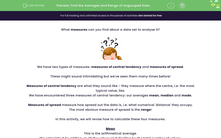What measures can you find about a data set to analyse it?

We have two types of measures: measures of central tendency and measures of spread.
These might sound intimidating but we've seen them many times before!
Measures of central tendency are what they sound like - they measure where the centre, i.e. the most typical value, lies.
We have encountered three measures of central tendency: our averages mean, median and mode.
Measures of spread measure how spread out the data is, i.e. what numerical 'distance' they occupy.
The most obvious measure of spread is the range!
In this activity, we will revise how to calculate these four measures.
Mean
This is the arithmetical average.
We calculate it by adding up all the values and dividing by the total number of values.
For example, if we consider the minimum temperatures in oC over 1 week:
7, 3.5, 2.5, -1, -4.5, 5, -2
We find the sum of all the values first:
7 + 3.5 + 2.5 - 1 - 4.5 + 5 - 2 = 10.5
Since there are seven numbers, we get:
Mean = sum of values ÷ number of values = 10.5 ÷ 7 = 1.5 oC

Median
This is the middle value when you place the values in ascending order (lowest number to highest number).
Let's have a look at an example:
A researcher is looking at the weekly study hours of a group of students. She has collected the following data:
To find the median, we put these in ascending order and crossing one from each side, we get:
Here, we have two numbers in the middle, so the median is the number right between these two numbers, i.e. their mean:
(7 + 8) ÷ 2 = 15 ÷ 2 = 7.5
We could also find the median by looking at which position it will occupy.
Since we have eight numbers in total, the median will be at the (8 + 1) ÷ 2 = 4.5th position, i.e. the number between the 4th and the 5th number!
These were 7 and 8 so we would end up with the same 7.5.

Mode
This is the most frequently occurring value or the most popular value.
Let's take the following data set of the number of siblings as an example:
We can see that 1 occurs three times, whereas 0, 2 and 3 occur only once or twice.
So 1 is the mode.
If two values occur the most number of times, we have two modes and the data set is called bimodal.
If all values occur the same number of times, then there is no mode.

Range
This is the difference between the biggest number and the smallest value:
range = highest value - smallest value
Let's look back at that set of numbers of siblings:
Let's have a go at some questions!








